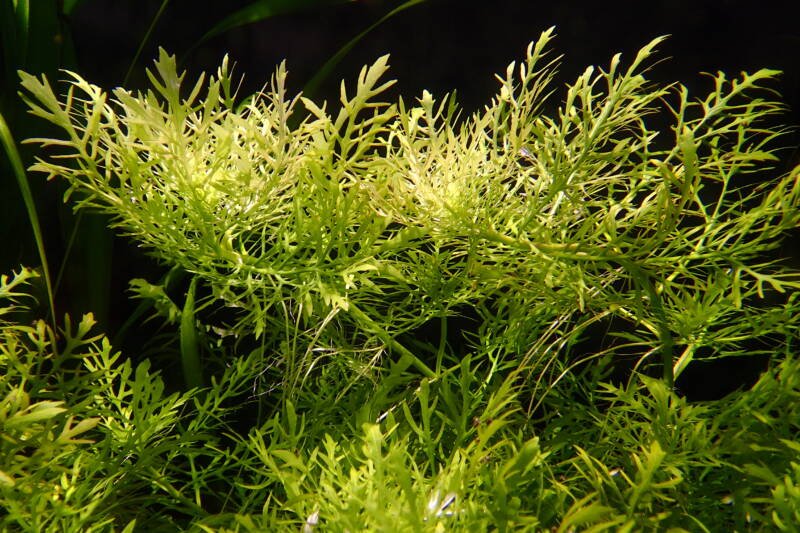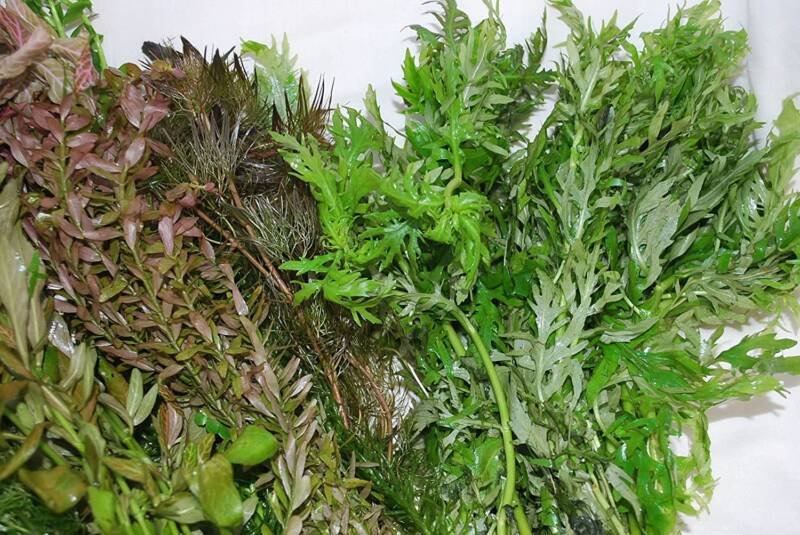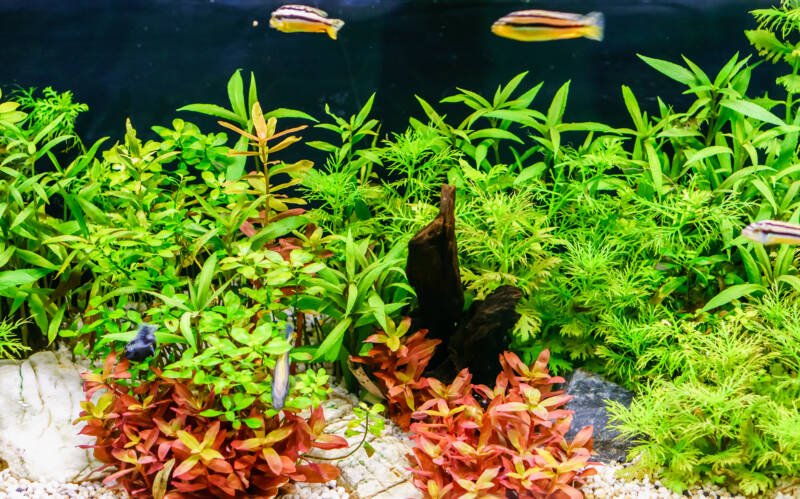Water wisteria is an undemanding and versatile aquarium plant. It’s favored by fish and aquarists alike for its vibrant colors and easy propagation.

It’s both readily available in stores and commonly present in home aquariums. Whether it’s used as a statement plant or to accentuate other aquascapes, water wisteria is sure to stand out.
In this article
Appearance and Basic Care
Water wisteria (Hygrophila difformis) is a beautiful but hardy freshwater plant. Its leaves grow off one central stalk, and it is a bright green color.
With the right lighting and CO2 supplements, the leaf shape will take on a forked or spiked appearance.
Fully mature plants have a thick or bushy appearance that makes them attractive when planted in bunches.
Regular pruning and plant supplements will encourage increased and healthy growth.
It can grow up to 20 inches high and 10 inches in diameter, making it ideal for both long and tall tanks. Its size also firmly classifies it as a background plant.
However, it can be used as a ground cover if an aquarist is willing to put in extra work and maintenance.
To do this, you would need to weigh down the plant on its side. Roots can grow from almost any part of the stalk, not just at the bottom, and leaves will eventually grow out instead of up from the main stem.
Its hardiness, appearance, and extensive foliage make it an attractive plant for both freshwater fish and aquarists.
Origin and Commercial Availability

Wisteria was originally found in India. It also appeared in neighboring countries such as Bangladesh, Thailand, Nepal, and more.
It most commonly appeared and grew during the rain season in shallow bodies of water. In its natural habitat, it can be found floating on the water’s surface or growing in its rooted form.
Because wisteria prefers shallow waters, this plant usually was only partially submerged, even when rooted in the substrate.
It has since spread to nurseries around the world and is a common aquarium plant. It is commercially grown and also available in aquacultured varieties.
Its popularity and availability mean it’s more affordable than some other freshwater plants, and even in bulk bunches, it’s often still a cost-effective way to plant your aquarium.
Aquarium Setup
This plant will need a minimum of 10 gallons to grow and thrive, although it would do better in larger tanks where it can truly spread out.
Because of this, it does incredibly well in column tanks. Its height and overall size can quickly outgrow smaller tanks without diligent pruning.
Even then, cutting down this plant to fit in such tanks will often make it look barer.
Besides providing it enough room, there are some other fundamental elements of the tank that water wisteria will need to thrive. These include:
- Substrate: Water wisteria needs a nutrient-rich substrate that will anchor it without crushing its root system. Mid-sized grain gravel is a right choice.
- Lighting: The more light this plant receives, the faster it will grow. Its leaves will also be bigger and bushier, and the plant overall will appear brighter and taller.
- Water Movement: Moderate water movement is fine for this plant, but a high current can easily displace it if the root system is not yet established.

The substrate is the most crucial element of the tank setup. But as stated above, this can be tricky.
The substrate should be able to anchor the roots without crushing them, which is not an easy feat. Though substrates with mid-sized granules work well, sandy substrate and fine gravel will also work.
However, you may need to anchor the plants in these. If using sand, you’ll also need to provide regular fertilizing tabs and increase your liquid nutrient doses.
Learning from the Natural Habitat
Another way to keep your wisteria safely planted on the aquarium floor is to utilize elements from its natural habitat. Planting water wisteria next to driftwood and rocks has three main benefits.
- Aesthetics: These additional features will create a more striking effect and make the wisteria’s colors stand out; you can use wood and rocks to imitate a natural environment or craft a specific aquascape
- Practicality: Driftwood and rocks give the wisteria’s root system additional anchors outside of the substrate; they help keep the wisteria near the bottom of the tank floor without having to utilize other, more bulky anchors
- Health: Adding driftwood and rocks in addition to plants from a fish’s original habitat makes it more likely to exhibit natural behaviors and thrive in the aquarium environment
This way, your wisteria will remain safely planted, no matter what type of substrate you have.
Using driftwood and rocks also gives you more leeway to cater the substrate to any specific needs of fish, rather than plants.
So if you have a bottom-dweller with sensitive barbels or fish that like to hide around rocks, you’ll still be able to meet their environmental needs.
Equipment for the Aquarium
Though the substrate is the essential element of the tank, there are also other pieces of aquarium equipment necessary for water wisteria to thrive truly.
This equipment, outlined below, controls the water parameters that wisteria prefers, which is discussed in the next section.
- Filtration: Any filter that doesn’t produce a current powerful enough to displace this plant will work well, whether it’s a HOB, canister, or internal filter.
- Heating: Since warmer water is necessary for wisteria to survive, a heater is required to keep the temperature in the mid- to upper ‘70s. A thermometer is also recommended.
- Lighting: These plants require moderate to high lighting. You’ll need a quality lighting system that is powerful enough to reach from the water’s surface to the substrate.
- Carbon Dioxide: Whether it’s through liquid dosing or a pressurized canister setup, CO2 is necessary for this plant to thrive truly.

Lighting and the CO2 setup are perhaps the most important aspects of the aquarium equipment listed above.
More often than not, the lighting system that comes with an aquarium isn’t sufficient for live plants. And tanks rarely come with a CO2 system included.
Aquarists should take extra care when purchasing these pieces of equipment to make sure they’re able to meet the tank’s current and future needs.
Water Parameters
Water wisteria is hardier than some other freshwater plants but still has preferred water parameter ranges. Though these ranges are broad, they should always be carefully monitored and maintained.
- pH Range: This plant prefers water that is either slightly acidic or close to neutral, anywhere from 6.5 – 7.5 pH.
- Temperature: Wisteria is a tropical plant that needs warmer waters to propagate, around 70 – 82 °F.
- Hardness: General water hardness is the easiest water parameter to match since a broad range of 2 – 8 KH is acceptable.
Like all aquarium plants, water wisteria does help soak up chemicals and keep your tank’s water quality acceptable.
However, they aren’t as purifying or powerful as other plants, such as duckweed. And they also can’t replace the function of regular water changes.
Without regular maintenance, they and your other tank inhabitants will be adversely affected by high levels of ammonia, nitrites, and nitrates.
Propagation Methods and Growth Rate
There are two ways that water wisteria can propagate: shoots and cuttings. As the wisteria thrives, it will grow shoots.
These shoots will, in turn, grow their leaves and, eventually, more shoots. This is its natural propagation method.
Using cuttings is another way to encourage growth and propagation. With this method, you cut the new shoots and replant them.
Make sure the cuts are clean, from sharp scissors, and not ragged or torn.
Replant them where they’ll be able to anchor easily. They’ll grow their own root system and turn into a new wisteria plant.
Either way, water wisteria has a very fast growth rate. It will quickly spread in the right environment.
For fish that require heavy vegetation to feel comfortable, this is a perfect choice. Many different types of aquarium inhabitants like water wisteria for hiding, spawning, and exploring.
This plant can grow emersed (partially underwater) or submerged (completely underwater).
Some aquarists have reported that water wisteria propagates and grows more quickly in an emersed environment.
However, starting the plant’s growth this way can also make it more challenging to transition it to a real aquarium. More intense lighting and additional supplements will be needed to ensure the plant survives and adjusts.
Water Wisteria in the Aquarium
The unique look of water wisteria’s leaves and its versatile growth grabbed the attention of the aquarium community and haven’t let go since.
Both new and experienced hobbyists have also come to appreciate its easy propagation and bright, lustrous presence.
Perhaps the only ones who love this plant more than aquarists are fish. The broad leaves and dense growth of water wisteria make it the perfect plant to explore, hide, and spawn in!